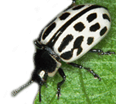Observations on the beetle fauna (Insecta - Coleoptera) of Scotch Broom | ||||||||||
Text © H.-J. Gießmann, C. Benisch, 2011 – Photos/movies © H.-J. Gießmann | ||||||||||
1. Introduction | ||||||||||
 Fig. 1: Scotch Broom Cytisus scoparius (a) habitus; (b) unripe fruit pods with feeding marks of recently hatched larvae of Bruchidius
Fig. 1: Scotch Broom Cytisus scoparius (a) habitus; (b) unripe fruit pods with feeding marks of recently hatched larvae of Bruchidius
Since several years, the lead author of this paper has observed a red-flowered shrub of Scotch Broom (Cytisus scoparius, Fig. 1) in a gravel pit located close to the highway A20
near Neukloster (Mecklenburg-Vorpommern, Nordwestmecklenburg district). In fall 2008, a few ripe yet closed fruit pods of the shrub were collected for the first time to harvest the seeds.  Fig. 2: (a) Scotch broom weevil Exapion fuscirostre, (b) Broom seed beetle Bruchidius villosus
Fig. 2: (a) Scotch broom weevil Exapion fuscirostre, (b) Broom seed beetle Bruchidius villosus
In the following years (2009–2011) the occurrence of both beetle species in various populations of Scotch Broom near Bad Doberan (Satow, Kritzmow, Hohenfelde) in the district of Rostock was further investigated.
During all years since 2008, both species have been present in the sampling areas. However, their relative abundance varied depending on year, location and sampling date. A sample of 101 closed fruit pods, collected from the sampling site Kritzmow in early August 2010 gave the result shown in table 1. Of those fruit pods infested by Exapion, 17 contained parasitic wasps at the same time. In the case of fruit pods infested by Bruchidius, four also contained parasitic wasps. In seven fruit pods only parasitic wasps were found, but no living adults of either Exapion or Bruchidius. In the latter case the hosts of the wasps were not identified, although determination is in principle possible by examination of the feeding marks of the beetle larvae on the seeds. It should be noted of course, that the sample and the results in table 1 are just a snapshot. It cannot be excluded that the seeds contained further unhatched beetles. | ||||||||||
2. Development of Bruchidius villosus | ||||||||||
|
The Broom seed beetle Bruchidius villosus places its oblong eggs on the surface of the fruit pod, where they are firmly affixed (Fig. 3a). The newly hatched larva either penetrates the husk immediately towards the inside of the pod, or makes a small burrow in the superficial tissue of the husk before finally entering the pod.  Fig. 3: (a) Eggs of the Broom seed beetle villosus on a fruit pod; (b) larva of Bruchidius villosus penetrates the broom seed near the hilum;
(c) larva of Bruchidius villosus in a opened broom seed.
Fig. 3: (a) Eggs of the Broom seed beetle villosus on a fruit pod; (b) larva of Bruchidius villosus penetrates the broom seed near the hilum;
(c) larva of Bruchidius villosus in a opened broom seed.Movie 1: Bruchidius villosus hatching
| ||||||||||
3. Development of Exapion fuscirostre | ||||||||||
|
So far the authors did not succeed to observe the egg deposition of the Scotch broom weevil Exapion fuscirostre. According to literature references the eggs are deposited in the pods.  Fig. 4: Exapion fuscirostre (a) larva on broom seed; (b) pupa in broom seed; (c) adult beetle shortly before leaving the seed. The cementing substance (yellow) is deposited around the hole eaten by the insect.
Fig. 4: Exapion fuscirostre (a) larva on broom seed; (b) pupa in broom seed; (c) adult beetle shortly before leaving the seed. The cementing substance (yellow) is deposited around the hole eaten by the insect.Movie 2: Exapion fuscirostre hatching
| ||||||||||
4. Parasites | ||||||||||
 Fig. 5: Braconid Triaspis cf. simulator: (a) female (left) and male (right) pupa; (b) female adult.
Fig. 5: Braconid Triaspis cf. simulator: (a) female (left) and male (right) pupa; (b) female adult.
In 2010, the abundance of parasitoid wasps (Hymenoptera, Braconidae) in the fruit pods was exceptionally high. A specimen has been determined by Prof. Kees van Achterberg
(Department of Terrestrial Zoology, Netherlands Centre for Biodiversity Naturalis, Leiden) as a member of the genus Triaspis, the species is most probably
Triaspis simulator (SZEPLIGETI, 1901) (Fig. 5). In 2011, parasitic infestation was present as well, however to a much lower extent than in 2010. Initially, the parasitic larvae were observed on the surface of the beetle larvae, however, at later stage of their development, the braconid larvae also partially penetrated the beetle larvae (movies 3 and 4). The infested beetle larvae seemed to be paralyzed and did not show any sign of defending moves. Depending on their host, the braconid larvae pupated within or at the empty seeds. Interestingly, the adult braconid wasps were also able to gnaw through the pericarp of the seed after hatching. Movie 3: Braconid larva parasitizes Bruchidius villosus
Movie 4: Braconid larva parasitizes Exapion fuscirostre
In early June 2011, besides the beetle larvae also larvae of gall midges (Diptera, Cecidomyiidae) were noted by their conspicuous lifestyle and agility. Under their feeding activity the young seeds shriveled, in most cases all seeds within the pod. Whether their presence disturbs or even prevents a successful development of Bruchidius and Exapion remains to be clarified. According to WALOFF (1968), the gall midge Contarinia pulchripes (KIEFFER, 1890) develops in Scotch Broom in England. The larvae of the gall midges were parasitized by wasps as well, most probably by chalcid wasps (Hymenoptera, Chalcidoidea, Fig. 6c).  Abb. 6: Larvae of gall midges: (a) Young larvae feeding on the ovule; (b) older larva; (c) hairy larva of a parasitic wasp (center) feeds on gall midge larva.
Abb. 6: Larvae of gall midges: (a) Young larvae feeding on the ovule; (b) older larva; (c) hairy larva of a parasitic wasp (center) feeds on gall midge larva. | ||||||||||
Closing remarks | ||||||||||
|
This topic page shall present snapshots from the life and development of beetles to the interested reader. It shall encourage the reader to explore and investigate seemingly inconspicuous creatures. Meanwhile, the two described beetle species have received widespread attention in a number of countries as a potential agent against excessive spreading of Scotch Broom on pasture land. | ||||||||||
Acknowledgements | ||||||||||
|
The authors thank Prof. Kees van ACHTERBERG for the determination of the braconid species. For the review of the draft and helpful discussions the authors want to thank Irina WÜRTELE and Klaas REISSMANN. | ||||||||||
Literature | ||||||||||
Articles and books:
Internet: | ||||||||||


